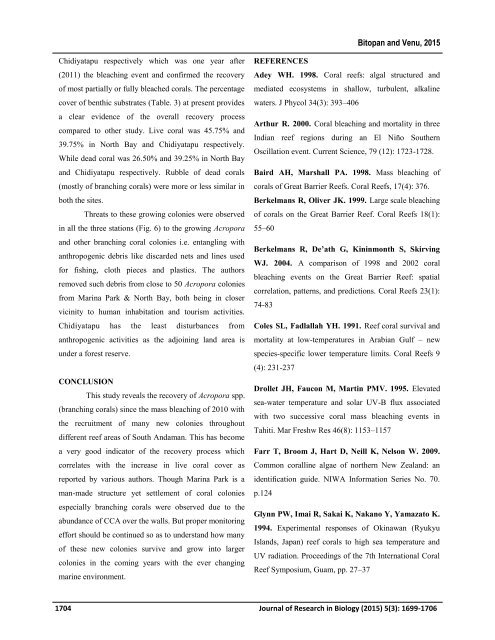New recruitment of Acropora Oken, 1815 in South Andaman- A proof of recovery of Corals after 2010 mass bleaching
You also want an ePaper? Increase the reach of your titles
YUMPU automatically turns print PDFs into web optimized ePapers that Google loves.
Bitopan and Venu, 2015<br />
Chidiyatapu respectively which was one year <strong>after</strong><br />
(2011) the bleach<strong>in</strong>g event and confirmed the <strong>recovery</strong><br />
<strong>of</strong> most partially or fully bleached corals. The percentage<br />
cover <strong>of</strong> benthic substrates (Table. 3) at present provides<br />
a clear evidence <strong>of</strong> the overall <strong>recovery</strong> process<br />
compared to other study. Live coral was 45.75% and<br />
39.75% <strong>in</strong> North Bay and Chidiyatapu respectively.<br />
While dead coral was 26.50% and 39.25% <strong>in</strong> North Bay<br />
and Chidiyatapu respectively. Rubble <strong>of</strong> dead corals<br />
(mostly <strong>of</strong> branch<strong>in</strong>g corals) were more or less similar <strong>in</strong><br />
both the sites.<br />
Threats to these grow<strong>in</strong>g colonies were observed<br />
<strong>in</strong> all the three stations (Fig. 6) to the grow<strong>in</strong>g <strong>Acropora</strong><br />
and other branch<strong>in</strong>g coral colonies i.e. entangl<strong>in</strong>g with<br />
anthropogenic debris like discarded nets and l<strong>in</strong>es used<br />
for fish<strong>in</strong>g, cloth pieces and plastics. The authors<br />
removed such debris from close to 50 <strong>Acropora</strong> colonies<br />
from Mar<strong>in</strong>a Park & North Bay, both be<strong>in</strong>g <strong>in</strong> closer<br />
vic<strong>in</strong>ity to human <strong>in</strong>habitation and tourism activities.<br />
Chidiyatapu has the least disturbances from<br />
anthropogenic activities as the adjo<strong>in</strong><strong>in</strong>g land area is<br />
under a forest reserve.<br />
CONCLUSION<br />
This study reveals the <strong>recovery</strong> <strong>of</strong> <strong>Acropora</strong> spp.<br />
(branch<strong>in</strong>g corals) s<strong>in</strong>ce the <strong>mass</strong> bleach<strong>in</strong>g <strong>of</strong> <strong>2010</strong> with<br />
the <strong>recruitment</strong> <strong>of</strong> many new colonies throughout<br />
different reef areas <strong>of</strong> <strong>South</strong> <strong>Andaman</strong>. This has become<br />
a very good <strong>in</strong>dicator <strong>of</strong> the <strong>recovery</strong> process which<br />
correlates with the <strong>in</strong>crease <strong>in</strong> live coral cover as<br />
reported by various authors. Though Mar<strong>in</strong>a Park is a<br />
man-made structure yet settlement <strong>of</strong> coral colonies<br />
especially branch<strong>in</strong>g corals were observed due to the<br />
abundance <strong>of</strong> CCA over the walls. But proper monitor<strong>in</strong>g<br />
effort should be cont<strong>in</strong>ued so as to understand how many<br />
<strong>of</strong> these new colonies survive and grow <strong>in</strong>to larger<br />
colonies <strong>in</strong> the com<strong>in</strong>g years with the ever chang<strong>in</strong>g<br />
mar<strong>in</strong>e environment.<br />
REFERENCES<br />
Adey WH. 1998. Coral reefs: algal structured and<br />
mediated ecosystems <strong>in</strong> shallow, turbulent, alkal<strong>in</strong>e<br />
waters. J Phycol 34(3): 393–406<br />
Arthur R. 2000. Coral bleach<strong>in</strong>g and mortality <strong>in</strong> three<br />
Indian reef regions dur<strong>in</strong>g an El Niño <strong>South</strong>ern<br />
Oscillation event. Current Science, 79 (12): 1723-1728.<br />
Baird AH, Marshall PA. 1998. Mass bleach<strong>in</strong>g <strong>of</strong><br />
corals <strong>of</strong> Great Barrier Reefs. Coral Reefs, 17(4): 376.<br />
Berkelmans R, Oliver JK. 1999. Large scale bleach<strong>in</strong>g<br />
<strong>of</strong> corals on the Great Barrier Reef. Coral Reefs 18(1):<br />
55–60<br />
Berkelmans R, De’ath G, K<strong>in</strong><strong>in</strong>month S, Skirv<strong>in</strong>g<br />
WJ. 2004. A comparison <strong>of</strong> 1998 and 2002 coral<br />
bleach<strong>in</strong>g events on the Great Barrier Reef: spatial<br />
correlation, patterns, and predictions. Coral Reefs 23(1):<br />
74-83<br />
Coles SL, Fadlallah YH. 1991. Reef coral survival and<br />
mortality at low-temperatures <strong>in</strong> Arabian Gulf – new<br />
species-specific lower temperature limits. Coral Reefs 9<br />
(4): 231-237<br />
Drollet JH, Faucon M, Mart<strong>in</strong> PMV. 1995. Elevated<br />
sea-water temperature and solar UV-B flux associated<br />
with two successive coral <strong>mass</strong> bleach<strong>in</strong>g events <strong>in</strong><br />
Tahiti. Mar Freshw Res 46(8): 1153–1157<br />
Farr T, Broom J, Hart D, Neill K, Nelson W. 2009.<br />
Common corall<strong>in</strong>e algae <strong>of</strong> northern <strong>New</strong> Zealand: an<br />
identification guide. NIWA Information Series No. 70.<br />
p.124<br />
Glynn PW, Imai R, Sakai K, Nakano Y, Yamazato K.<br />
1994. Experimental responses <strong>of</strong> Ok<strong>in</strong>awan (Ryukyu<br />
Islands, Japan) reef corals to high sea temperature and<br />
UV radiation. Proceed<strong>in</strong>gs <strong>of</strong> the 7th International Coral<br />
Reef Symposium, Guam, pp. 27–37<br />
1704 Journal <strong>of</strong> Research <strong>in</strong> Biology (2015) 5(3): 1699-1706

















